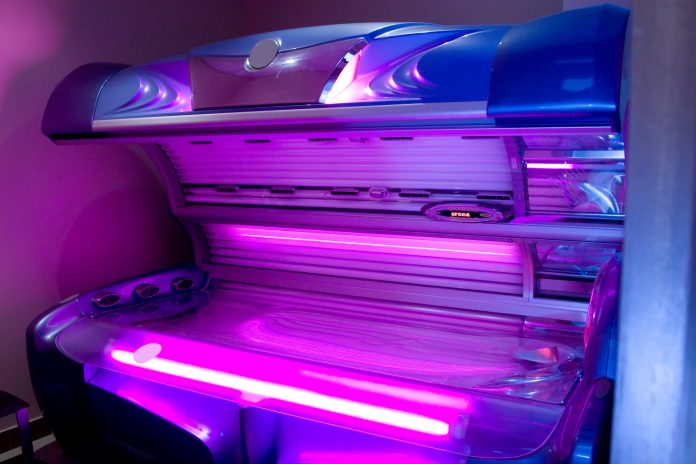Banning commercially available indoor tanning beds would prevent skin cancer and reduce deaths from the most serious form of skin cancer, known as melanoma
A study published to coincide with Melanoma Awareness Month has concluded that a ban on sunbeds would prevent skin cancer and reduce melanoma deaths.
The research team tracked the the impact of 618,000 18-year-olds living in England in 2019. They found that a ban on indoor tanning would result in 1,206 fewer cases of melanoma and 207 fewer melanoma deaths over their lifetimes.
Additionally, there would be 3,987 fewer cases of other more common types of skin cancer (squamous cell and basal cell carcinomas). Both of these cancers put a major strain on patients and the NHS.
The team analysed the cost-effectiveness of the policy on the NHS and obtained mortality data from Office for National Statistics. They compared a nationwide ban on commercial indoor tanning, combined with a public information campaign – with the status quo of availability of commercial indoor tanning.
The ban on sunbeds would save the NHS £700,000 and a Net Monetary Benefit of £10.6 million
In terms of cost savings, the policy would save the NHS £700,000 resulting in a Net Monetary Benefit of £10.6 million. However, when factoring in individuals that started to use sunbeds over the age of 18 years, the savings to the NHS would be far greater.
It is 99% likely that the information campaign will be cost effective.
The study has been led by researchers at the University of Manchester and published in the British Journal of Dermatology. The research was funded by the Manchester Cancer Research Centre.
The results add to a growing body of evidence from North America, Europe and Australia that supports a total ban on commercial sunbeds.
It has been proven that sunbeds cause cancer and yet they are still legal in the UK
In 2009, the International Agency for Research in Cancer declared that the ultraviolet radiation from commercial indoor tanning devices causes cancer in humans. Despite this study, it is currently legal for anyone over the age of 18 to use indoor tanning beds in the UK.
There has been some suggestion that use of sunbeds is decreasing but generally it is still widespread in many countries, including the UK.
Sunbed use is particularly high in the north-west of England and in cities with greater social deprivation. This is thought to be able to explain the unusually high rates of melanoma that can be found amongst young women in the north-west of England.
Rates of skin cancer amongst men have also increased by 50% in the last ten years.
Children under 18 in England are also illegally using sunbeds – the figure is expected to be about 62,000.
How would banning sunbeds prevent skin cancer and melanoma deaths?
Paul Lorigan, a Professor of Oncology at The University of Manchester and Honorary Consultant Medical Oncologist at the Christie NHS Foundation Trust has explained how the ban could prevent skin cancer and reduce deaths: “If the NHS invested in a public health campaign to support the ban on sunbeds, we estimate that melanoma and other skin cancers would be significantly reduced, NHS resources would be saved and deaths averted.
“It is quite clear that melanoma and keratinocyte skin cancers have a significant impact on population health and healthcare budgets, and that a proportion are attributable to indoor tanning. Anyone who has used a sunbed increases their risk of melanoma by almost 60%.
“We show quite conclusively for the first time that banning indoor tanning supported by a public health campaign would be an efficient use of healthcare resources to reduce melanoma and other skin cancers in England.
“Our findings agree with calculations of future productivity losses that were caused by these diseases in the USA in mainly young people in 2015 after exposure to tanning devices. There the total economic losses amounted to over $US127 billion over the individuals’ lifetimes.”
Susanna Daniels, CEO at Melanoma Focus, said: “The rates of melanoma skin cancer are increasing in the UK yet 86% of cases are preventable. We strongly advise the avoidance of sunbeds.”
The research from the University of Manchester has been disputed by the Sunbed Association. They made the following comment: “We utterly refute the mathematically theoretical claims made in this study, not least because it relies heavily on data from studies conducted outside of the UK where the sunbed industry is not as well-regulated as it is here. But unequivocally, there is no reliable evidence that responsible non-burning use of a professionally operated sunbed by someone who can tan, will increase their risk of melanoma.”
Dr Sarah Carlick, a melanoma cancer survivor, now campaigns to raise awareness about UV light and prevent skin cancer
In 2018, just a day after her graduation, a lump in Carlick’s collarbone area was diagnosed as stage three malignant melanoma, over six years after she had a cancerous freckle excised.
Following an operation and gruelling treatment in 2019, Carlick suffered many side effects including extreme fatigue. As a result of her tiredness, she was sometimes wheelchair bound and forced to take time off work.
Carlick’s targeted therapy finished just before 2020 but it took her two years to completely recover.
Because of her experiences, she is now campaigns to raise awareness about the dangers of UV light, sunbathing and use of sunbeds.
She said: “I wasn’t aware of the seriousness of sun protection growing up and I regularly got sunburnt as a child, as well as being a user of sunbeds in the family home as a young adult.
“But now I find it hard to watch anyone going anywhere near a sunbed because I know just how dangerous it is.
“The industry needs to take responsibility for the danger they are subjecting their clients to. Like the dangers of smoking are now highly visible on cigarette packets, there also needs to be a highly visible warning in the salons themselves.”











